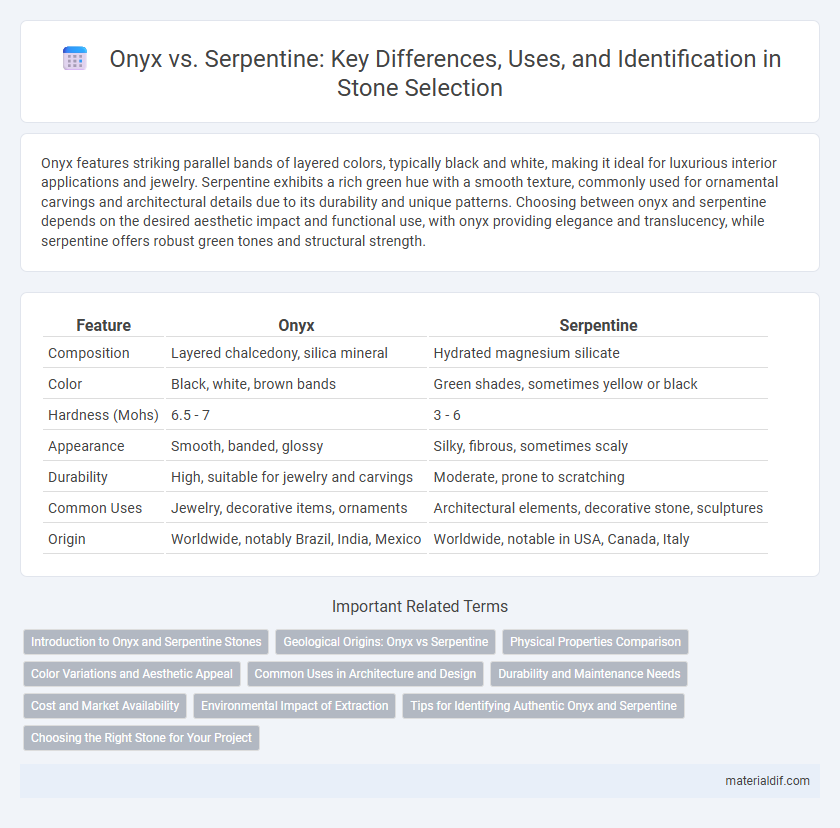Onyx features striking parallel bands of layered colors, typically black and white, making it ideal for luxurious interior applications and jewelry. Serpentine exhibits a rich green hue with a smooth texture, commonly used for ornamental carvings and architectural details due to its durability and unique patterns. Choosing between onyx and serpentine depends on the desired aesthetic impact and functional use, with onyx providing elegance and translucency, while serpentine offers robust green tones and structural strength.
Table of Comparison
| Feature | Onyx | Serpentine |
|---|---|---|
| Composition | Layered chalcedony, silica mineral | Hydrated magnesium silicate |
| Color | Black, white, brown bands | Green shades, sometimes yellow or black |
| Hardness (Mohs) | 6.5 - 7 | 3 - 6 |
| Appearance | Smooth, banded, glossy | Silky, fibrous, sometimes scaly |
| Durability | High, suitable for jewelry and carvings | Moderate, prone to scratching |
| Common Uses | Jewelry, decorative items, ornaments | Architectural elements, decorative stone, sculptures |
| Origin | Worldwide, notably Brazil, India, Mexico | Worldwide, notable in USA, Canada, Italy |
Introduction to Onyx and Serpentine Stones
Onyx is a banded variety of chalcedony, characterized by parallel layers of black, white, or brown, often used in jewelry and decorative items due to its striking contrast and smooth texture. Serpentine is a group of green to yellow-green minerals with a waxy or silky luster, frequently found in metamorphic rocks and valued for its use as a decorative stone and in carvings. Both stones are prized for their unique colors and patterns, making them popular choices in ornamental and architectural applications.
Geological Origins: Onyx vs Serpentine
Onyx forms through the deposition of silica in gas cavities within lava, leading to banded chalcedony layers with quartz and moganite minerals. Serpentine originates from the alteration of ultramafic rocks, primarily peridotite, through hydrothermal metamorphism, resulting in a group of magnesium-rich phyllosilicate minerals. The distinct geological processes highlight Onyx's volcanic sedimentary roots compared to Serpentine's metamorphic mantle-derived formation.
Physical Properties Comparison
Onyx is a banded variety of chalcedony with a hardness of 6.5 to 7 on the Mohs scale, showing excellent durability and a smooth, glassy luster. Serpentine, usually softer with a Mohs hardness of 2.5 to 4, exhibits a waxy or greasy texture and is more prone to scratching and weathering. The density of onyx ranges around 2.55-2.70 g/cm3, while serpentine is lighter, typically between 2.2 and 2.6 g/cm3, influencing their suitability for various decorative and structural uses.
Color Variations and Aesthetic Appeal
Onyx features striking, banded color variations ranging from deep blacks and browns to creamy whites, giving it a dramatic and elegant aesthetic appeal that suits sophisticated interiors. Serpentine displays a more subdued color palette, often exhibiting shades of green, yellow, and cream with smooth, mottled patterns, imparting a natural, earthy vibe ideal for rustic or organic designs. The distinct visual characteristics of onyx and serpentine cater to different stylistic preferences, with onyx offering bold contrast and serpentine providing subtle warmth.
Common Uses in Architecture and Design
Onyx is prized in architecture and design for its translucent beauty, often used in backlit wall panels, countertops, and decorative accents to create luxurious, luminous interiors. Serpentine, valued for its durability and rich green hues, frequently serves as a structural stone in flooring, cladding, and sculptural elements, especially in traditional and contemporary settings. Both stones offer unique aesthetic and functional qualities, with onyx emphasizing elegance and light, while serpentine provides strength and natural color depth.
Durability and Maintenance Needs
Onyx, a form of chalcedony quartz, offers moderate durability but requires careful maintenance due to its susceptibility to scratches and acids, making it ideal for low-traffic areas. Serpentine, softer and more porous than onyx, demands more frequent sealing and gentle cleaning to prevent staining and damage. Both stones need regular upkeep; however, onyx is generally more resilient, while serpentine requires greater attention to preserve its appearance.
Cost and Market Availability
Onyx commands higher prices due to its rarity and demand in luxury decor, with costs typically ranging from $15 to $50 per square foot, while serpentine is more affordable, often priced between $5 and $15 per square foot. Onyx's availability is more limited, sourced mainly from countries like Mexico, Pakistan, and Iran, making it less accessible in mainstream markets. Serpentine is widely available globally, especially in regions such as the United States, Italy, and China, contributing to its lower cost and greater market presence.
Environmental Impact of Extraction
Onyx extraction involves quarrying, which can cause significant landscape disruption and generate substantial waste rock, affecting local ecosystems. Serpentine mining typically requires less invasive methods, leading to a lower environmental footprint and reduced habitat destruction. Both stones demand responsible sourcing to minimize soil erosion, water contamination, and biodiversity loss during extraction processes.
Tips for Identifying Authentic Onyx and Serpentine
Authentic onyx features parallel bands with a consistent pattern of black and white or colored layers, while genuine serpentine displays a smooth, waxy texture often with green hues and occasional veining. Testing hardness reveals onyx ranks around 6.5-7 on the Mohs scale, making it harder than serpentine, which falls between 2.5-5. Observing weight and temperature aids identification; onyx feels cooler and denser, whereas serpentine is lighter and warmer to the touch.
Choosing the Right Stone for Your Project
Onyx offers a striking, translucent appearance with smooth, wavy patterns ideal for decorative interior elements like countertops and backsplashes, while serpentine features a more durable, dense composition with rich green and yellow hues suited for flooring and outdoor applications. Selecting the right stone depends on the project's environmental exposure, desired aesthetic, and maintenance requirements; onyx requires careful sealing to prevent damage, whereas serpentine's hardness provides greater resistance to wear. Prioritizing the stone's physical properties and visual impact ensures longevity and enhances the overall design harmony in residential or commercial projects.
Onyx vs Serpentine Infographic

 materialdif.com
materialdif.com